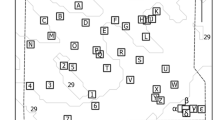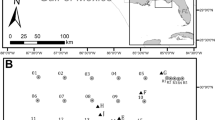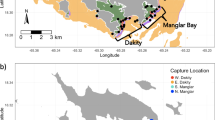Abstract
Estuaries contain mosaic habitats which support fish across different life stages. Artificial reefs represent a form of habitat enhancement which can provide additional structure for fishes and improve fishing opportunities, but the role of artificial reefs within the broader estuarine seascape has not been extensively studied. We used a VEMCO Positioning System (VPS) to monitor the fine-scale movements of yellowfin bream (Acanthopagrus australis, referred to as Bream), an estuarine predator and important recreational species. Fish were implanted with acoustic tags with accelerometer sensors (to measure relative fish activity), and their movements monitored on an artificial reef and adjacent habitats. Elevated activity patterns during crepuscular periods indicated that foraging was likely occurring over a large seagrass bed adjacent to the artificial reef system. Alternatively, lower activity was observed when fish were on the artificial reef, which may reflect the role of this habitat as a refuge, or that alternative foraging strategies were being employed. All fish exhibited a high degree of fidelity to the artificial reef on which they were tagged, and there was minimal movement among other reef groups within the array. There was extensive overlap in space use contours for smaller fish on the seagrass edge, but no overlap for larger fish that also tended to forage further afield. These findings have implications for the way in which artificial reefs support fish production, especially the importance of connectivity with other key habitats within the estuarine seascape.





Similar content being viewed by others
References
Abecasis, D., L. Bentes, P.G. Lino, M.N. Santos, and K. Erzini. 2013. Residency, movements and habitat use of adult white seabream (Diplodus sargus) between natural and artificial reefs. Estuarine, Coastal and Shelf Science 118: 80–85.
Beck, M.W., K.L. Heck Jr., K.W. Able, D.L. Childers, D.B. Eggleston, B.M. Gillanders, B. Halpern, C.G. Hays, K. Hoshino, T.J. Minello, R.J. Orth, P.F. Sheridan, and M.P. Weinstein. 2001. The identification, conservation, and management of estuarine and marine nurseries for fish and invertebrates. Bioscience 51 (8): 633–641.
Bohnsack, J.A., and D.L. Sutherland. 1985. Artificial reef research: a review with recommendations for future priorities. Bulletin of Marine Science 37: 11–39.
Buxton, C.D., and P.A. Garratt. 1990. Alternative reproductive styles in seabreams (Pisces: Sparidae). Environmental Biology of Fishes 28 (1-4): 113–124.
Champion, C., I.M. Suthers, and J.A. Smith. 2015. Zooplanktivory is a key process for fish production on a coastal artificial reef. Marine Ecology Progress Series 541: 1–14.
Clark, S., and A.J. Edwards. 1994. Use of artificial reef structures to rehabilitate reef flats degraded by coral mining in the Maldives. Bulletin of Marine Science 55: 724–744.
Costa, M.J., J. Costa, P.R. de Almeida, and C.A. Assis. 1994. Do eel grass beds and salt marsh borders act as preferential nurseries and spawning grounds for fish? An example of the Mira estuary in Portugal. Ecological Engineering 3 (2): 187–195.
Cresson, P., S. Ruitton, M. Ourgaud, and M. Harmelin-Vivien. 2014. Contrasting perception of fish trophic level from stomach content and stable isotope analyses: a Mediterranean artificial reef experience. Journal of Experimental Marine Biology and Ecology 452: 54–62.
Curley, B.G., A.R. Jordan, W.F. Figueira, and V.C. Valenzuela. 2013. A review of the biology and ecology of key fishes targeted by coastal fisheries in south-east Australia: identifying critical knowledge gaps required to improve spatial management. Reviews in Fish Biology and Fisheries 23 (4): 435–458.
D’Anna, G., V.M. Giacalone, C. Pipitone, and F. Badalamenti. 2011. Movement pattern of white seabream, Diplodus sargus (L., 1758)(Osteichthyes, Sparidae) acoustically tracked in an artificial reef area. Italian Journal of Zoology 78 (2): 255–263.
Dance, M.A., and J.R. Rooker. 2015. Habitat-and bay-scale connectivity of sympatric fishes in an estuarine nursery. Estuarine, Coastal and Shelf Science 167: 447–457.
Fabi, G., and L. Fiorentini. 1994. Comparison between an artificial reef and a control site in the Adriatic Sea: analysis of four years of monitoring. Bulletin of Marine Science 55: 538–558.
Fabi, G., S. Manoukian, and A. Spagnolo. 2006. Feeding behavior of three common fishes at an artificial reef in the northern Adriatic Sea. Bulletin of Marine Science 78: 39–56.
Folpp, H., M. Lowry, M.A. Gregson, and I.M. Suthers. 2011. Colonisation and community development of fish assemblages assciated with estuarine artificial reefs. Brazilian Journal of Oceanography 59 (spe1): 55–67.
Folpp, H., M. Lowry, M. Gregson, and I.M. Suthers. 2013. Fish assemblages on estuarine artificial reefs: natural rocky-reef mimics or discrete assemblages? PLoS One 8 (6): e63505.
Gannon, R., N.L. Payne, I.M. Suthers, C.A. Gray, D.E. van der Meulen, and M.D. Taylor. 2015. Fine-scale movements, site fidelity and habitat use of an estuarine dependent sparid. Environmental Biology of Fishes 98 (6): 1599–1608.
Gannon, R., M.D. Taylor, I.M. Suthers, C.A. Gray, D.E. van der Meulen, J.A. Smith, and N.L. Payne. 2014. Thermal limitation of performance and biogeography in a freeranging ectotherm: insights from accelerometry. Journal of Experimental Biology 217 (17): 3033–3037.
Granneman, J.E., and M.A. Steele. 2015. Effects of reef attributes on fish assemblage similarity between artificial and natural reefs. ICES Journal of Marine Science / Journal du Conseil 72 (8): 2385–2397.
Gray, C.A., D.J. McElligott, and R.C. Chick. 1996. Intra- and inter-estuary differences in assemblages of fishes associated with shallow seagrass and bare sand. Marine and Freshwater Research 47 (5): 723–735.
Gray, C.A., R.C. Chick, and D.J. McElligott. 1998. Diel changes in assemblages of fishes associated with shallow seagrass and bare sand. Estuarine, Coastal and Shelf Science 46 (6): 849–859.
Henderson, M.J., M.C. Fabrizio, and J.A. Lucy. 2014. Movement patterns of summer flounder near an artificial reef: effects of fish size and environmental cues. Fisheries Research (Amsterdam) 153: 1–8.
Keller, K., J.A. Smith, M.B. Lowry, M.D. Taylor, and I.M. Suthers. 2017. Multispecies presence and connectivity around a designed artificial reef. Marine and Freshwater Research 68 (8): 1489. https://doi.org/10.1071/MF16127.
Koeck, B., J. Alós, A. Caro, R. Neveu, R. Crec’hriou, G. Saragoni, and P. Lenfant. 2013. Contrasting fish behavior in artificial seascapes with implications for resources conservation. PLoS One 8 (7): e69303.
Lowry, M., H. Folpp, M. Gregson, and R. McKenzie. 2010. Assessment of artificial reefs in Lake Macquarie NSW: NSW Industry & Investement.
MacIntyre, R. 1959. Some aspects of the ecology of Lake Macquarie, N.S.W., with regard to an alleged depletion of fish. VII. The benthic macrofauna. Marine and Freshwater Research 10 (3): 341–353.
Macreadie, P.I., J.S. Hindell, M.J. Keough, G.P. Jenkins, and R.M. Connolly. 2010. Resource distribution influences positive edge effects in a seagrass fish. Ecology 91 (7): 2013–2021.
Melville, A.J., and R.M. Connolly. 2003. Spatial analysis of stable isotope data to determine primary sources of nutrition for fish. Oecologia 136 (4): 499–507.
Miller, D. 2008. A comparison of fish and epibenthic assemblages on artificial reefs with and without copper-based anti-fouling paint MSc thesis, 96. Alabama: Auburn University.
Moreno, I. 2002. Effects of substrate on the artificial reef fish assemblage in Santa Eulalia bay (Ibiza, western Mediterranean). ICES Journal of Marine Science Journal du Conseil 59: S144–S149.
Neves dos Santos, L., and I. Zalmon. 2015. Long-term changes of fish assemblages associated with artificial reefs off the northern coast of Rio de Janeiro, Brazil. Journal of Applied Ichthyology 31: 15–23.
NSW Department of Primary Industries. 2015. A guide to acceptable proceedures and practices for aquaculture and fisheries research. 3rd ed, 56. Primary Industries (Fisheries) Animal Care and Ethics Committee: Nelson Bay.
O’Toole, A., K. Murchie, C. Pullen, K. Hanson, C. Suski, A. Danylchuk, and S. Cooke. 2011. Locomotory activity and depth distribution of adult great barracuda (Sphyraena barracuda) in Bahamian coastal habitats determined using acceleration and pressure biotelemetry transmitters. Marine and Freshwater Research 61: 1446–1456.
Özgül, A., A. Lök, A. Ulaş, F.O. Düzbastılar, T.T. Tanrıkul, and C. Pelister. 2015. Preliminary study on the use of the Vemco Positioning System to determine fish movements in artificial reef areas: a case study on Sciaena umbra Linnaeus, 1758. Journal of Applied Ichthyology 31: 41–47.
Payne, N.L., M.D. Taylor, Y. Watanabe, and J.M. Semmens. 2014. From physiology to physics: are we recognizing the flexibility of biologging tools? Journal of Experimental Biology 217 (3): 317–322.
Payne, N.L., D.E. van der Meulen, I.M. Suthers, C.A. Gray, and M.D. Taylor. 2015a. Foraging intensity of wild mulloway Argyrosomus japonicus decreases with increasing anthropogenic disturbance. Marine Biology 162 (3): 539–546.
Payne, N.L., D.E. van der Meulen, I.M. Suthers, C.A. Gray, C.T. Walsh, and M.D. Taylor. 2015b. Rain-driven changes in fish dynamics: a switch from spatial to temporal segregation. Marine Ecology Progress Series 528: 267–275.
Payne, N.L., D.E. van der Meulen, R. Gannon, J.M. Semmens, I.M. Suthers, C.A. Gray, and M.D. Taylor. 2013. Rain reverses diel activity rhythms in an estuarine teleost. Proceedings of the Royal Society B - Biological Sciences 280: 20122363.
Payne, N.L., J.A. Smith, D.E. van der Meulen, M.D. Taylor, Y.Y. Watanabe, A. Takahashi, T.A. Marzullo, C.A. Gray, G. Cadiou, and I.M. Suthers. 2016. Temperature-dependence of fish performance in the wild: links with species biogeography and physiological thermal tolerance. Functional Ecology 30 (6): 903–912.
Pease, B., J. Bell, J. Burchmore, M. Middleton, and D. Pollard. 1981. The ecology of fish in Botany Bay: biology of commercially and recreationally valuable species. In In Environmental Control Study of Botany Bay, 287. Sydney: State Pollution Control Commission.
Pollock, B.R. 1984. Relations between migration, reproduction and nutrition in yellowfin bream Acanthopagrus australis. Marine Ecology Progress Series 19: 17–23.
Pollock, B.R. 1985. The reproductive cycle of yellowfin bream, Acanthopagrus australia (Gunther), with particular reference to protandrous sex inversion. Journal of Fish Biology 26 (3): 301–311.
Potter, I.C., G.A. Hyndes, and F.M. Baronie. 1993. The fish fauna of a seasonally closed Australian estuary. Is the prevalence of estuarine-spawning species high? Marine Biology 116 (1): 19–30.
Potts, J., A. Wright, J. Neilson, R. Connolly, and P. Scanes. 2011. An assessment of foodwebs in Lake Macquarie using carbon and nitrogen stable isotopes, 46. Sydney NSW: NSW Office of Environment and Heritage.
R Core Team. 2016. R: a language and environment for statistical computing. Vienna: R Foundation for Statistical Computing.
Schroepfer, R.L., and S.T. Szedlmayer. 2006. Estimates of residence and site fidelity for red snapper Lutjanus campechanus on artificial reefs in the northeastern Gulf of Mexico. Bulletin of Marine Science 78: 93–101.
Steffe, A.S., J.J. Murphy, D.J. Chapman, and C.A. Gray. 2005. An assessment of changes in the daytime recreational fishery of Lake Macquarie following the establishment of a ‘recreational fishing haven’, 103. Cronulla: NSW Department of Primary Industries - Fisheries.
Tanoue, H., T. Komatsu, T. Tsujino, I. Suzuki, M. Watanabe, H. Goto, and N. Miyazaki. 2012. Feeding events of Japanese Lates japonicus detected by a high-speed video camera and three-axis micro-acceleration data-logger. Fisheries Science 78 (3): 533–538.
Taylor, M.D., B. Fry, A. Becker, and N.A. Moltschaniwskyj. 2017a. Recruitment and connectivity influence the role of seagrass as a penaeid nursery habitat in a wave dominated estuary. Science of the Total Environment 584–585: 622–630.
Taylor, M.D., N.L. Payne, A. Becker, and M.B. Lowry. 2017b. Feels like home: homing of mature large-bodied fish following translocation from a power-station canal. ICES Journal of Marine Science Journal du Conseil 74: 301–310.
Taylor, M.D., L. McPhan, D.E. van der Meulen, C.A. Gray, and N.L. Payne. 2013. Interactive drivers of activity in a free-ranging estuarine predator. PLoS One 8 (11): e80962.
Taylor, M.D., R.C. Chick, K. Lorenzen, A.L. Agnalt, K.M. Leber, H.L. Blankenship, G. Vander Haegen, and N.R. Loneragan. 2017c. Fisheries enhancement and restoration in a changing world. Fisheries Research 186: 407–412.
Tolimieri, N., K. Andrews, G. Williams, S. Katz, and P.S. Levin. 2009. Home range size and patterns of space use by lingcod, copper rockfish and quillback rockfish in relation to diel and tidal cycles. Marine Ecology Progress Series 380: 229–243.
van der Meulen, D.E., C.T. Walsh, M.D. Taylor, and C.A. Gray. 2014. Habitat requirements and spawning strategy of an estuarine-dependent fish, Percalates colonorum. Marine and Freshwater Research 65 (3): 218–227.
Wallace, J.H., H.M. Kok, L.E. Beckley, B. Bennett, S.J.M. Blaber, and A.K. Whitfield. 1984. South African estuaries and their importance to fishes. South African Journal of Science 80: 203–207.
Walsh, C.T., I.V. Reinfelds, M.C. Ives, C.A. Gray, R.J. West, and D.E. van der Meulen. 2013. Environmental influences on the spatial ecology and spawning behaviour of an estuarine-resident fish, Macquaria colonorum. Estuarine, Coastal and Shelf Science 118: 60–71.
West, L.D., K.E. Stark, J.J. Murphy, J.M. Lyle, and F.A. Ochwada-Doyle. 2016. Survey of Recreational Fishing in New South Wales and the ACT, 2013/14. Nelson Bay, Fisheries Final Report Series No. 149: NSW Department of Primary Industries, p. 150
Zuur, A.F., E.N. Ieno, N.J. Walker, A.A. Saveliev, and G.M. Smith. 2009. Mixed effects models and extensions in ecology with R: Springer.
Acknowledgements
The authors wish to thank those that have assisted in the fish tracking research conducted on Lake Macquarie since 2013, namely J. McLeod, N. Payne, E. Mitchell, I. Thiebaud, E. Messer, A. Fowler, G. Cadiou, S. Chilcott, R. Brownette, G. Dobson, B. Marsland, B. Grasso and J. Tranter. The authors also wish to acknowledge the NSW Recreational Fishing Saltwater Trust who provided funding for this study, and in kind support provided by staff at Origin Energy. Capture of fish in Lake Macquarie was permitted under Section 37 of the NSW Fisheries Management Act 1994, through Scientific Research Permit number P01/0059, and animals were handled under Animal Research Authority 12/17 issued by the NSW Department of Primary Industries—Fisheries Animal Care and Ethics Committee.
Author information
Authors and Affiliations
Corresponding author
Additional information
Communicated by Ken Dunton
Rights and permissions
About this article
Cite this article
Taylor, M.D., Becker, A. & Lowry, M.B. Investigating the Functional Role of an Artificial Reef Within an Estuarine Seascape: a Case Study of Yellowfin Bream (Acanthopagrus australis). Estuaries and Coasts 41, 1782–1792 (2018). https://doi.org/10.1007/s12237-018-0395-6
Received:
Revised:
Accepted:
Published:
Issue Date:
DOI: https://doi.org/10.1007/s12237-018-0395-6




